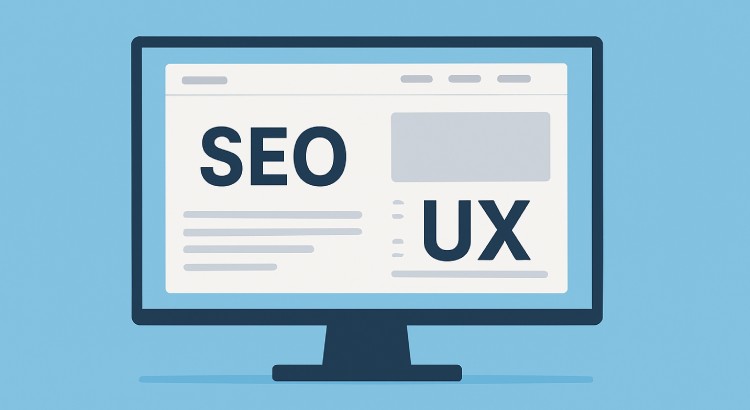User experience and SEO are closely connected when it comes to building a high-performing website. SEO depends heavily on how visitors interact with a site, from how fast it loads to how easy it is to use. This guide will explain how user experience impacts visibility, rankings, and overall online success.
What Is User Experience (UX)?
User experience (UX) is the overall feeling and satisfaction a person gets while interacting with a website, application, or digital product. It includes how easy the site is to navigate, how quickly it loads, how useful the content is, and how visually appealing the design appears.
In simple terms, good UX means a visitor can smoothly move through your site and find what they need without frustration. It creates positive impressions, builds trust, and leads users to return. on the other hand, poor UX can lead to higher bounce rates, lost sales, and low retention.
How Does UX Impact SEO?
Usability and search visibility now go hand in hand, as Google increasingly rewards pages that offer real value to visitors. A smooth experience supports both discoverability and engagement.
While visibility efforts bring traffic in, a well-structured interface keeps visitors on the page and encourages action. If navigation is confusing or content is hard to access, rankings can suffer.
1. Keeps Visitors on Your Site
A clear structure helps users find what they’re looking for quickly. The longer they stay, the stronger the signal to search engines that your content is useful, which supports better visibility.
2. Guides Users to Key Information
No matter where someone lands—home or product page—they should easily find relevant content. Good structure improves navigation and encourages deeper browsing.
3. Boosts Conversions
When people have a smooth journey, they’re more likely to take action. A reliable and clear layout builds trust and increases the chance of converting visitors into customers.
4. Encourages Repeat Visits
A positive past experience makes people more likely to return. Whether through email suggestions or reminders, familiar users are easier to re-engage when they remember a seamless interaction.
What UX Factors Affect SEO Performance?
Several UX elements directly impact how your site performs in search engine rankings:
- Performance: Fast-loading, responsive pages offer a smoother experience and are more likely to be favored by search engines.
- Mobile Compatibility: With mobile-first indexing in place, it’s essential your site functions seamlessly across smartphones and tablets.
- Design and Layout: Clean formatting, logical structure, and readable content help users stay engaged and find what they need without friction.
- Ease of Use: Simple navigation, clearly labeled buttons, and accessible interfaces ensure all visitors can interact with your site effortlessly.
How to Optimize UX to Improve SEO Results?
Here’s how to align your website’s experience with search visibility goals:
1. Create Content That Matches Search Intent
To keep visitors engaged and encourage them to stay longer, your content should match the reason behind their search. This helps ensure people find the exact information or solution they’re looking for.
There are four main types of search intent:
- Informational: The user is looking to learn something (e.g., how to make pizza, what is cryptocurrency).
- Navigational: The goal is to find a specific site or page (e.g., Facebook login, Amazon Prime).
- Commercial: The user is comparing options before making a decision (e.g., best gaming laptops 2025, best DSLR cameras under 1 lakh).
- Transactional: The person is ready to take action, often to make a purchase (e.g., buy MacBook Pro, Nike Air Max sale).
When your content directly addresses the user’s purpose, it leads to higher engagement and longer visits. These behaviors send strong quality signals that can improve visibility in search results.
To achieve this alignment, start by researching top-ranking pages for your target keyword. This helps you understand the type of content your audience expects to see.
2. Make Content Easy to Read
Readable content improves user experience, keeps visitors engaged, and helps search engines understand your pages more clearly. Here’s how to enhance readability:
- Keep paragraphs and sentences short: Use two- to three-sentence paragraphs and concise sentences to avoid overwhelming readers.
- Use clear headings: Add H2, H3, and H4 tags to organize your content and guide users through it quickly.
- Add visuals: Include relevant images, charts, or diagrams to break up text and clarify key points.
- Format for quick scanning: Use bullet points, lists, and bold text to highlight information users can find at a glance.
- Simplify your language: Unless your audience is technical, aim for content that’s easy for most people to understand.
3. Aim for an Accessible and Visually Appealing Website
Creating a site that looks good and is accessible to all users, including those with disabilities, supports SEO by encouraging positive user engagement. Here’s how to achieve this:
- Choose a clean, modern design: Avoid clutter and focus on layouts that enhance readability.
- Keep branding consistent: Use uniform colors, fonts, and design elements for a cohesive look.
- Select legible fonts: Use clear typefaces and appropriate sizes to ensure easy reading.
- Add descriptive alt text to images: This helps search engines and visually impaired users understand your visuals.
- Enable keyboard navigation: Ensure your site can be fully used via keyboard for better accessibility.
Many CMS platforms and website builders simplify following these best practices.
4. Improve Site Structure and Navigation
A clear, well-organized website helps users quickly find what they need and enables search engines to crawl and index your pages efficiently. Organize your site into a logical hierarchy where your homepage links to category pages, and those categories link to individual pages.
Your URLs should reflect this structure:
- Homepage: yourwebsite.com
- Category page: yourwebsite.com/first-category
- Individual page: yourwebsite.com/first-category/first-individual-page
This approach improves both user experience and search engine understanding of your site.
5. Improve Page Performance
Fast and responsive pages boost user experience and can positively affect search rankings. Use Google’s PageSpeed Insights tool to evaluate your pages by entering a URL; it will provide suggestions for improvement.
Key ways to enhance performance include:
- Optimize images: Use modern formats like WebP for smaller file sizes without losing quality, and compress images with tools like TinyPNG.
- Minify code: Reduce the size of your code files without affecting functionality—consider consulting a developer.
- Minimize redirects: Remove unnecessary redirects, especially chains and loops, since too many can slow your site down.
- Choose a reliable hosting provider: Select a hosting service known for good performance; cloud hosting, which uses multiple servers, is often a strong choice.
6. Ensure Your Site Is Mobile-Friendly
With over half of web traffic coming from mobile devices and Google using the mobile version of your site for indexing and ranking, having a mobile-friendly site is essential.
To make your site mobile-friendly:
- Use responsive design: Ensure your website adapts automatically to different screen sizes, from smartphones to tablets, providing a smooth experience for all users.
- Optimize tap targets: Make buttons and links large and spaced well to avoid accidental clicks.
- Minimize intrusive pop-ups: Avoid full-screen pop-ups on mobile. If you use them, keep them small and purposeful.
Use Google’s PageSpeed Insights tool to test your site’s mobile performance by entering your URL for detailed feedback.
Conclusion
UX and SEO influence each other in meaningful ways that affect how users interact with your site and how search engines rank it. A smooth, intuitive experience encourages users to stay longer on the site and engage more, which supports stronger visibility in SERPs. When both elements are aligned, your website becomes more effective at meeting user needs and search engine expectations.


